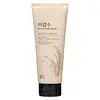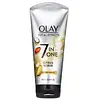What's inside
What's inside
 Key Ingredients
Key Ingredients

 Benefits
Benefits

 Concerns
Concerns

 Ingredients Side-by-side
Ingredients Side-by-side

Water
Skin ConditioningGlycerin
HumectantStearic Acid
CleansingMyristic Acid
CleansingLauric Acid
CleansingPotassium Hydroxide
BufferingCeteareth-20
CleansingCocamidopropyl Betaine
CleansingSilica
AbrasiveDisodium Cocoamphodiacetate
CleansingCocamide Mea
EmulsifyingGlyceryl Stearate
EmollientPEG-100 Stearate
PEG-7 Glyceryl Cocoate
EmulsifyingOryza Sativa Bran
AbrasiveOryza Sativa Extract
AbsorbentOryza Sativa Bran Oil
EmollientSodium Lauryl Sulfate
CleansingHexylene Glycol
EmulsifyingParfum
MaskingSodium Chloride
MaskingPolyquaternium-7
Disodium EDTA
Saponaria Officinalis Leaf Extract
AntimicrobialHydroxypropyl Methylcellulose
Emulsion StabilisingTheobroma Cacao Extract
Skin ConditioningWater, Glycerin, Stearic Acid, Myristic Acid, Lauric Acid, Potassium Hydroxide, Ceteareth-20, Cocamidopropyl Betaine, Silica, Disodium Cocoamphodiacetate, Cocamide Mea, Glyceryl Stearate, PEG-100 Stearate, PEG-7 Glyceryl Cocoate, Oryza Sativa Bran, Oryza Sativa Extract, Oryza Sativa Bran Oil, Sodium Lauryl Sulfate, Hexylene Glycol, Parfum, Sodium Chloride, Polyquaternium-7, Disodium EDTA, Saponaria Officinalis Leaf Extract, Hydroxypropyl Methylcellulose, Theobroma Cacao Extract
Water
Skin ConditioningSodium Lauroamphoacetate
CleansingGlycerin
HumectantSorbitol
HumectantPEG-200 Hydrogenated Glyceryl Palmate
CleansingSodium Myristoyl Sarcosinate
CleansingHydrated Silica
AbrasiveAcrylates Copolymer
Sodium Trideceth Sulfate
CleansingNiacinamide
SmoothingPanthenol
Skin ConditioningTocopheryl Acetate
AntioxidantAscorbic Acid
AntioxidantBHT
AntioxidantSalicylic Acid
MaskingPEG-7 Glyceryl Cocoate
EmulsifyingSodium Laureth Sulfate
CleansingGlycol Distearate
EmollientParfum
MaskingPEG-100
HumectantLauric Acid
CleansingCitric Acid
BufferingPolyquaternium-10
Cocamide Mea
EmulsifyingDisodium EDTA
Menthol
MaskingLaureth-10
EmulsifyingMethylchloroisothiazolinone
PreservativeMethylisothiazolinone
PreservativeCI 19140
Cosmetic ColorantCI 16035
Cosmetic ColorantWater, Sodium Lauroamphoacetate, Glycerin, Sorbitol, PEG-200 Hydrogenated Glyceryl Palmate, Sodium Myristoyl Sarcosinate, Hydrated Silica, Acrylates Copolymer, Sodium Trideceth Sulfate, Niacinamide, Panthenol, Tocopheryl Acetate, Ascorbic Acid, BHT, Salicylic Acid, PEG-7 Glyceryl Cocoate, Sodium Laureth Sulfate, Glycol Distearate, Parfum, PEG-100, Lauric Acid, Citric Acid, Polyquaternium-10, Cocamide Mea, Disodium EDTA, Menthol, Laureth-10, Methylchloroisothiazolinone, Methylisothiazolinone, CI 19140, CI 16035
 Reviews
Reviews

Ingredients Explained
These ingredients are found in both products.
Ingredients higher up in an ingredient list are typically present in a larger amount.
We don't have a description for Cocamide Mea yet.
Disodium EDTA plays a role in making products more stable by aiding other preservatives.
It is a chelating agent, meaning it neutralizes metal ions that may be found in a product.
Disodium EDTA is a salt of edetic acid and is found to be safe in cosmetic ingredients.
Learn more about Disodium EDTAGlycerin is already naturally found in your skin. It helps moisturize and protect your skin.
A study from 2016 found glycerin to be more effective as a humectant than AHAs and hyaluronic acid.
As a humectant, it helps the skin stay hydrated by pulling moisture to your skin. The low molecular weight of glycerin allows it to pull moisture into the deeper layers of your skin.
Hydrated skin improves your skin barrier; Your skin barrier helps protect against irritants and bacteria.
Glycerin has also been found to have antimicrobial and antiviral properties. Due to these properties, glycerin is often used in wound and burn treatments.
In cosmetics, glycerin is usually derived from plants such as soybean or palm. However, it can also be sourced from animals, such as tallow or animal fat.
This ingredient is organic, colorless, odorless, and non-toxic.
Glycerin is the name for this ingredient in American English. British English uses Glycerol/Glycerine.
Learn more about GlycerinLauric Acid is a fatty acid or lipid. About half of fatty acids in coconut oil is lauric acid.
This ingredient helps hydrate and sooth skin. As a humectant, it helps trap moisture. It also aids in cleaning and enhancing the texture of products.
Lauric acid may not be Malassezia folliculitis, or fungal acne, safe.
Learn more about Lauric AcidParfum is a catch-all term for an ingredient or more that is used to give a scent to products.
Also called "fragrance", this ingredient can be a blend of hundreds of chemicals or plant oils. This means every product with "fragrance" or "parfum" in the ingredients list is a different mixture.
For instance, Habanolide is a proprietary trade name for a specific aroma chemical. When used as a fragrance ingredient in cosmetics, most aroma chemicals fall under the broad labeling category of “FRAGRANCE” or “PARFUM” according to EU and US regulations.
The term 'parfum' or 'fragrance' is not regulated in many countries. In many cases, it is up to the brand to define this term.
For instance, many brands choose to label themselves as "fragrance-free" because they are not using synthetic fragrances. However, their products may still contain ingredients such as essential oils that are considered a fragrance by INCI standards.
One example is Calendula flower extract. Calendula is an essential oil that still imparts a scent or 'fragrance'.
Depending on the blend, the ingredients in the mixture can cause allergies and sensitivities on the skin. Some ingredients that are known EU allergens include linalool and citronellol.
Parfum can also be used to mask or cover an unpleasant scent.
The bottom line is: not all fragrances/parfum/ingredients are created equally. If you are worried about fragrances, we recommend taking a closer look at an ingredient. And of course, we always recommend speaking with a professional.
Learn more about ParfumPeg-7 Glyceryl Cocoate is created from polyethylene glycol and fatty acids from coconut oil.
It is a synthetic polymer with emulsifying and cleansing properties.
As an emulsifier, Peg-7 Glyceryl Cocoate prevents ingredients such as oils and water from separating. It also helps rinse away oils, dirt, and pollutants from skin.
Peg-7 Glyceryl Cocoate may not be fungal acne safe. It can also dry out skin.
Learn more about PEG-7 Glyceryl CocoateWater. It's the most common cosmetic ingredient of all. You'll usually see it at the top of ingredient lists, meaning that it makes up the largest part of the product.
So why is it so popular? Water most often acts as a solvent - this means that it helps dissolve other ingredients into the formulation.
You'll also recognize water as that liquid we all need to stay alive. If you see this, drink a glass of water. Stay hydrated!
Learn more about Water